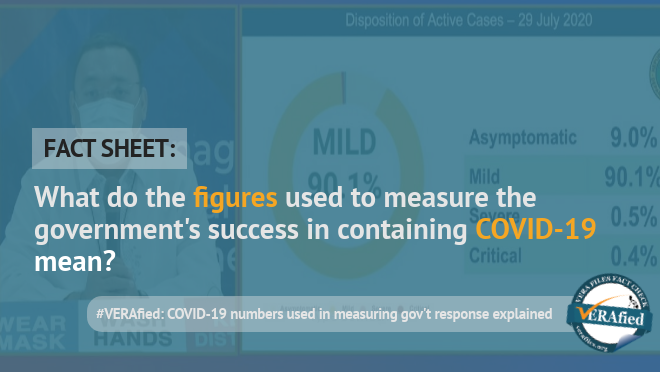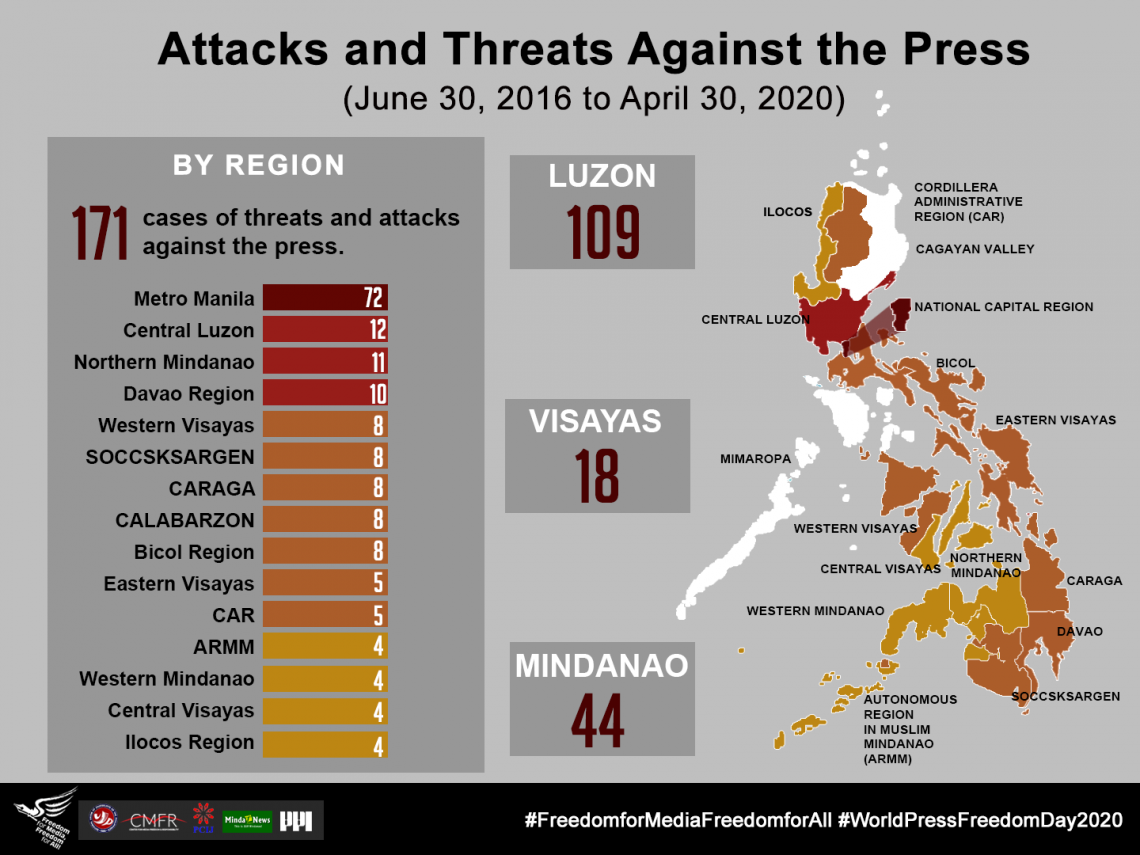There’s more to the coronavirus disease 2019 (COVID-19) battlecry “flattening the curve” than meets the eye. The rates of success in a pandemic include technical terms such as mortality and case fatality, recovery, case doubling time, positivity, and critical care utilization. What do these mean and how is the Philippines faring in these numbers?
Latest data from the Department of Health (DOH) show that the country’s case fatality rate at 1.68 percent as of Aug. 10 is better than the 3.70 percent global average. Its positivity rate of 10 percent is double the five percent global benchmark.
Meanwhile, the reproduction number of cases slightly dropped from 1.04 persons getting infected to an average of 1.31 as of Aug. 11, while the case doubling time increases by two-fold roughly every nine days.
In several press briefings, Presidential Spokesperson Harry Roque boasted that these statistics reflect the government’s effective response to the health crisis. Roque had claimed the government’s quarantine strategies such as placing the entire Luzon under enhanced community quarantine (ECQ) from March 17 to April 30, and extended until May 31 in selected areas, “prepared” the country’s healthcare capacity before easing restrictions for the economy.
In expectation versus reality, the worsening COVID-19 figures on the ground prompted the medical community to plead to President Rodrigo Duterte on Aug. 1 to revert to ECQ for 15 days in the National Capital Region (NCR) and nearby provinces. Duterte subsequently heeded the distress call of frontliners but only with a modified ECQ in NCR, Laguna, Cavite, Rizal and Bulacan as a compromise with the business community.
More than 80 medical institutions led by the Philippine College of Physicians (PCP) asked for the ECQ as a “time out” for the already “overwhelmed” healthcare system. The groups said COVID-19 hospital wards have been congested after thousands of infected patients swarmed their facilities and the health workforce already “burnt out,” with some falling ill to the virus.
The groups suspect the failure of testing, with some local governments using rapid testing kits instead of the “gold standard” reverse transcription-polymerase chain reaction (RT-PCR), and inadequate isolation measures of the government contributed to the surge of new cases.
The health workers said ECQ could be an opportunity to address the seven “urgent problems” they identified in the government’s COVID-19 response. These problems include congested hospitals, depleted health workforce, delayed distribution of government assistance and poor compliance of the public to health protocols.
But some of the concerns they raised are among the government’s commitments since the early stages of the imposition of quarantine measures in March. Duterte even appointed czars in July to lead the testing, tracing, treatment, and isolation strategies of the government.
Despite increasing cases of COVID-19, Roque said the public need not be “shocked” as he reiterated the government’s strategy against the pandemic is “effective” with the intensified testing, contact tracing, and isolation capacities. Roque has previously said the rising number of COVID-19 cases is not “alarming” but something that “should concern all of us.”
Here is a list of statistics commonly cited in the government’s response to the COVID-19 pandemic and what they mean:
1. Mortality and case fatality rates
There are two methods used to measure COVID-19-related deaths:
- case fatality rate (CFR), which divides the number of deaths by the number of confirmed cases, then multiplied by 100; and,
- mortality rate, which is usually calculated per 1,000 or 100,000 population for a specific period.
CFR is not constant because it changes with the context, depending on factors such as the location and characteristic of the infected population, like age and sex, according to Our World in Data, a research group based at the University of Oxford in the United Kingdom.
The Johns Hopkins Coronavirus Research Center also identified testing as a factor affecting mortality, noting that, “with more testing, more people with milder cases are identified.” This then lowers the CFR, it said.
Noting similar concerns, healthcare expert Nemuel Fajutagana of nonprofit Medical Action Group told VERA Files in an earlier interview that the CFR is still the “most appropriate” measurement at this time. (See VERA FILES FACT CHECK: Duterte’s remark that PH has low mortality rate needs context)
However, some epidemiologists prefer the term case fatality “ratio” rather than case fatality “rate,” saying that it is more accurate, according to the United States Centers for Disease Control and Prevention (CDC). The World Health Organization (WHO) said some “authors” have attempted to rectify the use of the term “rate” in CFR which denotes a “time component” that is actually absent in it.
WHO said the “true severity” of a disease, such as COVID-19, can be described by the Infection Fatality Ratio (IFR), which “estimates (the) proportion of deaths among all infected individuals.”
Data as of Aug. 10 show the case fatality rate in the country is at 1.68 percent, at least a notch below the WHO global rate of 3.70 percent as of Aug. 8. In an Aug. 10 case bulletin, DOH said the latest global CFR is 3.62 percent, but it did not cite a source for the adjustment.
Roque had erroneously interchanged mortality rate with CFR on at least two occasions in July alone.
DOH data indicate a rise and fall trend in the daily number of deaths since late March. For the first time since March 19, the department reported zero fatality on July 9. This was, however, followed by a sudden spike of 42 deaths recorded the next day. On Aug. 11 , 19 new deaths were reported, bringing the total to 2,312
2. Recovery rate
Case recovery rate is defined as the proportion of recovered patients compared to the total number of cases identified since the start of the outbreak.
On July 30, DOH recorded the country’s record-high number of recoveries with 38,075 in one day, bringing the total to 65,064, from 26,996 the previous day. As of Aug. 11, the country’s recovery rate was at 49.04 percent, following the recovery of 68,432 patients out of the 139,598 total cases.
The DOH numbers do not tally because of corrections in “duplicate cases” in the previous days.
In a press statement, DOH explained the big leap in the number of recovered patients was a result of data reconciliation with local government units through Oplan Recovery. It said “patients with mild or no symptoms are tagged as recovered 14 days from the date of onset of symptoms or by date specimen collection,” even without confirmatory tests to determine if they are already negative for coronavirus.
3. Case doubling time
The longer the time it takes for the number of cases to increase, the better chances officials have to contain and slow down the transmission of COVID-19. DOH data, as of Aug. 10, show it takes 9.26 days before the total number of positive cases in the country doubles.
The time-varying reproduction number, on the other hand, is a “lagging indicator,” according to DOH. It is measured by symptom onset and does not take into account the 14-16 days “between symptoms, health-seeking, testing, and reporting.” Latest data from DOH show a reproduction number of 1.31 as of Aug. 11, which means one infected person could have infected one or two more people in the past two weeks.
DOH said the goal is to get the reproduction number below one percent, which would mean that a COVID-positive person is infecting less than one other person on average. This suggests the start of effectively controlling the spread of the disease, according to LEADS for Health Security and Resilience Consortium led by the Philippine Society of Public Health Physicians (PSPHP).
DOH has been reporting over a thousand new cases every day since late July. Its record-high number of new cases on a single day was on Aug. 10 with 6,958 confirmed infections.
On Aug. 7, the Philippines logged the highest number of confirmed COVID-19 cases in Southeast Asia as well as among member states in WHO Western Pacific Region, including China — the origin of COVID-19. (See VERA FILES FACT CHECK: Roque errs in COVID-19 data, wrongly classifies countries in WHO regional grouping)
4. Positivity rate
Positivity rate pertains to the percentage of people who tested positive for COVID-19 compared to the total tests conducted.
Since July 3, the government has prioritized testing for symptomatics and asymptomatics from select sectors, including health frontliners, media, and government workers. On July 30, testing czar Vivencio Dizon said the 30,000 target tests per day in July has been met and surpassed with 33,000 tests recorded on July 25. But data from DOH show that daily individual tests on the succeeding days fluctuated between 24,000 and 32,000 until Aug. 8 before it dropped to 18,126 on Aug. 9.
WHO advised governments to maintain their positivity rate at five percent or lower for at least 14 days before easing quarantine restrictions. The latest data from the health department show the country’s positivity rate rising from 8.90 percent on July 27 to 10 percent as of Aug. 10.
As of Aug. 11, 99 testing laboratories all over the country have tested 1.70 million individuals and 2.97 million testing kits are available, the DOH data show.
5. Critical care utilization
As of Aug. 10, 809 out of 1,926 dedicated facilities for COVID-19 are still at safe level. The rest of the facilities are at warning (217) and danger (263) levels. When summed up, the total is different. The DOH clarified that “facilities with either no dedicated COVID beds as of (the previous day) or no ICU beds, such as infirmaries” are excluded in its status tracker for COVID-dedicated facilities.
Meantime, mechanical ventilators currently in use are 632 out of 2,088 units, while total bed occupancy is at 50.09 percent, or 8,652 out of 17,270 beds are occupied.
Roque announced during a public address of the president on July 31 that COVID-dedicated beds in government hospitals need to be increased from 30 to 50 percent and, in private hospitals, from 20 to 30 percent, as the number of cases surpassed 93,000 since Duterte eased community quarantines and reopened the economy.
Roque’s announcement came two days after DOH Undersecretary Maria Rosario Vergeire declared on July 28 that the nationwide occupancy rate for all COVID-19 beds has reached the warning level of 52.3 percent. But DOH Undersecretary Leopoldo Vega, the designated chief treatment czar, clarified on July 30 that the hospitals in the “danger zone” are those which have not fully allocated the required 30 percent beds for COVID-19 patients, noting the average allocation was only at 16 percent.
Early in July, Roque bragged that the Luzon-wide ECQ was meant to capacitate the country’s health care system in treating critical and severe COVID-19 patients, which were more or less 0.6 percent of the cases that time, when the economy reopened.
As of Aug.11, severe and critical patients each have 0.60 percent of the 68,794 active cases out of 139,538 total confirmed infections. Other cases are asymptomatics (7.20 percent) and mild (91.60 percent).
Cities and provinces with a high number of cases are Quezon City (12,819), Manila City (9,289), Cebu City (9,142) and Laguna (6,000) as of Aug. 11.
Sources
Department of Health, DOH: PHILIPPINES LEADS IN TESTING IN SOUTHEAST ASIA; INCREASING CASES ATTRIBUTED TO INCREASED TESTING AND COMMUNITY TRANSMISSION, Aug. 6,2020
World Health Organization, COVID-19 situation updates for week 32 (2 – 8 August 2020), Accessed Aug. 9, 2020
Department of Health, Philippine Situationer #104, Aug. 9, 2020
Department of Health, Philippine Situationer #105, Aug. 10, 2020
Department of Health, Case Bulletin #149, Aug. 10, 2020
Department of Health, Case Bulletin #135 , July 27, 2020
Department of Health, Case Bulletin #148, Aug., 9, 2020
Department of Health, Philippine Situationer #106, Aug. 11, 2020
Department of Health, Case Bulletin #150, Aug. 11, 2020
Presidential Communications Operations Office, Palace affirms gov’t recovery plan on COVID-19, July 28, 2020
RTVMalacanang, Press Briefing by Presidential Spokesperson Harry Roque, Jr. 7/7/2020, July 7, 2020
Presidential Communications Operations Office, NCR is now MECQ; 20M face masks for the poor – Presidential Communications Operations Office, Aug. 2, 2020
Philippine College of Physicians, More than 80 medical societies are supporting the frontliners’ call for a timeout., Aug. 1, 2020
Phiippine College of Physicians, Joint Statement, Aug. 1, 2020
Official Gazette, Memorandum Order from the Executive Secretary, March 16, 2020
Official Gazette, Executive Order No. 112, April 12, 2020
Presidential Communications Operations Office, Palace releases MECQ details, May 13,2020
Presidential Communications Operations Office, Gov’t assigns PH anti-COVID czars, July 13, 2020
Department of Health, COVID-19 Philippine Situationer #102, Aug. 7, 2020
Rappler.com, Harry Roque virtual press briefing | Tuesday, August 4, Aug. 4, 2020
CNN Philippines, The Source: Harry Roque (07.22.20), July 22, 2020
World Health Organization, Estimating mortality from COVID-19, Aug. 4, 2020
Email correspondence, Interview with University of the Philippines Statistics Prof. Peter Cayton,
Center for Disease Control and Prevention, Principles of Epidemiology in Public Health Practice, Third Edition An Introduction to Applied Epidemiology and Biostatistics Section 3: Mortality Frequency Measures, Accessed Aug. 7, 2020
News Literacy Project, Understanding COVID-19 data: Case fatality rate vs. mortality rate vs. risk of dying, April 14, 2020
Department of Health, DOH UPDATES DATA PRESENTATION, HIGHLIGHTS THREE KEY INDICATORS OF IMPROVING SITUATION, May 30, 2020
Our World in Data, What do we know about the risk of dying from COVID-19?, March 25, 2020
Johns Hopkins Coronavirus Resource Center, Mortality Analyses, Accessed Aug, 7, 2020
LEADS for Health Security and Resilience Consortium, LEADS: Leading Evidence-based Actions through Data Science for Health Security and Resilience, Accessed Aug, 7, 2020
RTVMalacanang, Press Briefing by Presidential Spokesperson Harry Roque, Jr. 7/7/2020, July 7, 2020
RTVMalacanang, Press Briefing by Presidential Spokesperson Harry Roque, Jr. 7/9/2020, July 9, 2020
Department of Health, DOH COVID-19 Bulletin #117 , July 9, 2020
Department of Health, DOH COVID-19 Bulletin #118 , July 10, 2020
Department of Health, DOH COVID-19 Case Bulletin #146 , Aug. 7, 2020
Endcov.ph, Statistics, Accessed Aug. 7, 2020
Department of Health, COVID-19 tracker, Accessed Aug. 12, 2020
Department of Health, DOH tags 38K Recoveries from Oplan Recovery, July 30, 2020
Department of Health, Case Bulletin #137, July 29, 2020
Department of Health,TIGNAN…Paano nga ba madedeklarang “recovered” ang isang pasyenteng…, July 31, 2020
Department of Health, Philippine Situationer #98, Aug. 3, 2020
Department of Health, Case Bulletin #143, Aug. 4, 2020
Association of Southeast Asian Nations, ASEAN BioDiaspora Virtual Center, Aug. 7, 2020
World health Organization, WPRO COVID-19 DashboaRd, Accessed Aug. 7, 2020
Department of Health, ECQ Buys PH Time; Continued Practice of Healthy Behavior Needed to Sustain Gains, May 7, 2020
Presidential Communications Operations Office, IATF approves NTF’s new action plan, expanded testing strategy, July 3, 2020
Presidential Communications Operations Office, Palace reports decline in COVID-19 reproduction number, July 3, 2020
World Health Organization, , Public health criteria to adjust public health and social measures in the context of COVID-19, May 21, 2020
RTVMalacanang, WATCH: Palace virtual presser with Presidential Spokesperson Harry Roque | July 30, 2020, July 30, 2020
PTV, WATCH: DOH Presscon | July 28, 2020, July 28, 2020
RTVMalacanang, WATCH: President Rodrigo Roa #Duterte Public Address, July 7, 2020
(Guided by the code of principles of the International Fact-Checking Network at Poynter, VERA Files tracks the false claims, flip-flops, misleading statements of public officials and figures, and debunks them with factual evidence. Find out more about this initiative and our methodology.)





